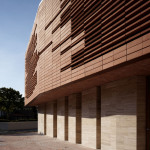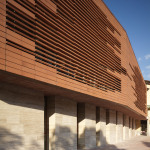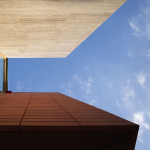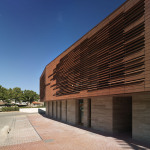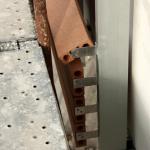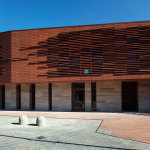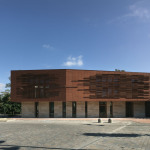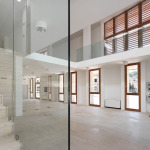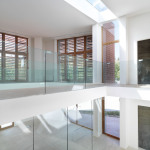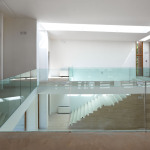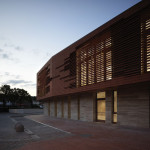10 Apr The Library of Greve in Chianti: a terracotta façade recalling design and tradition
The municipal library of Greve in Chianti, designed by Architects Mdu, was constructed in an urban area, previously occupied by abandoned industrial buildings, located within the UMI 1 area and situated near the historical center. The site, which has a mainly flat terrain, is almost triangular in shape and is bordered south by Viale Vittorio Veneto opposite to Piazza Trento, on the north by the Greve river and on the eastside by a pedestrian area and new residential and commercial buildings. The building is characterized by the use of terracotta, typical construction material of the Chianti region, totally redesigned for this occasion, creating an abstract geometry of the façade consisting of lines and variations of light and shade, apt to evoke the image of rows of vines typical of the surrounding landscape.
The uniqueness of the project lies in the design of the ventilated terracotta façade, which includes a rain screen and a brise-soleil application. Two natural elements have been used to realize the façade: the perimeter walls are covered with travertine, while the brise-soleil cladding in terracotta is fixed to the primary structure of the building merely on the upper and lower parts of the construction, creating a single and slander span
The system was designed by the Palagio Engineering team according to the project requirements: the terracotta facade, with its warm colors and soft shades, welcomes the users of the library as in a protective shell with an ideal sense of comfort. The brise-soleils create a mutual, but still discreet, visual contact between the external and internal environment; they are realized with TerraTube elements with internal star-shaped openings allow the installation with different inclinations. Rotating around their axis, the 15 x 50 cm dimensioned terracotta tubes assume different inclinations, providing so an abstract geometry of lines and variety of light and shades to the façade which evokes the image of parallel rows of vines of the surrounding hills.
Terracotta, building material par excellence of the territory, has so been revised and adapted to meet shapes and language of modern architecture.
Technique
The external skin is realized with two different facade systems, a rain screen and a brise-soleil system. TerraTube elements, with a 150×50 mm section and the characteristic star-shaped internal opening, allowing the use of one single fixing bracket to obtain inclinations of 45°, 90° and 180°, have been used for the brise-soleil application.
For the library project, two additional inclinations with respect to the horizontal position – 33° and 16°- have been selected and obtained through the use of customized lateral brackets. The façade is realized with 1000 mm long, preassembled louvers, fastened laterally to the rectangular tracks.
The cladding system is connected to the primary structure of the building merely on top and bottom of the construction, creating a single and slender span.The rain screen cladding is realized with a TerraTube application, with same sectional dimensions of 150×50 mm, fixed to the backup wall by means of omega clips inserted into the shaped rear of the terracotta profile for an invisible fixing, and then fastened to the rectangular vertical tracks. Also the window surrounds, standing out as true and deep scores, have been realized with a rain screen system. The production chain of cladding with Impruneta terracotta is short. The production plant only makes use of natural clay extracted from the local quarry (Chianti fiorentino), free from any toxicity or radioactivity granted by an environmental restoration program.
The design of the terracotta profiles allows easy installation with simple but safe systems which maintain the external surface intact.The clips to hold the terracotta panels are positioned inside proper kerfs to grant high load capacity and easy replacement. The terracotta profiles also permit the use of different mechanical anchoring systems to best suit the project requirements and the scheduled installation sequences. The anchoring system for the terracotta elements is realized in totally recyclable, extruded aluminum, with dimensional sections that fit the ventilation chambers, and accessories in stainless steel. The system is composed of vertical support profiles, placed at a distance equal to the length of the terracotta panels and fixed to the backup wall through proper brackets by means of mechanical and/or chemical anchor bolts.
Slots in the brackets anchored to the wall grant compensation of possible out-of-squares of the primary structure and allow, at the same time, independent dilatation of the individual components of the anchoring system, avoiding thermal coactions. The outer layer realized with terracotta elements, technically also referred to as sealing layer, has both a protective function of the internal elements from meteoric precipitations as well as an aesthetical function representing and distinguishing the architectural profile of the building. The main aspect of the design of the ventilated façade lies in the static autonomy of each element of the parameter and in the elimination of the mortar padding. The cladding elements do not adhere directly to the structural support and are so free to move according to the proper coefficient of expansion (independently from the movements of the structural support) and to follow the settling movements and oscillation of the load-bearing structures thanks to the elasticity of the anchors.
- Terratube technology with star-shaped hole
- The terracotta façade at night recalling a lantern

